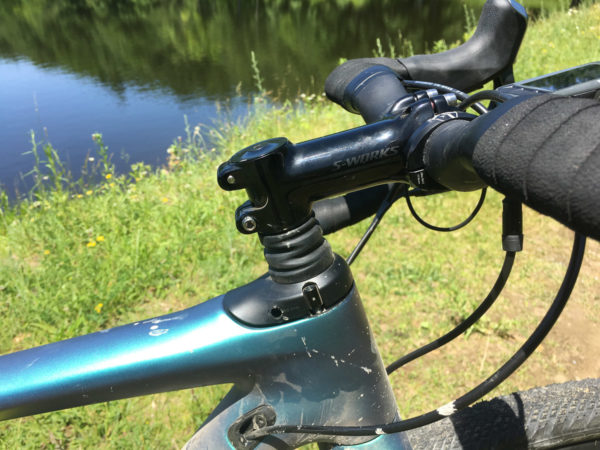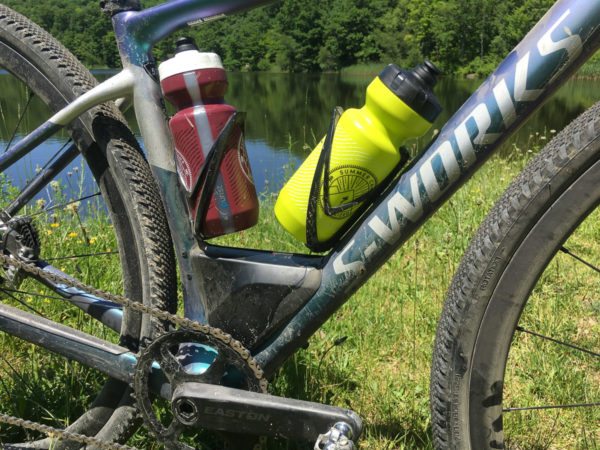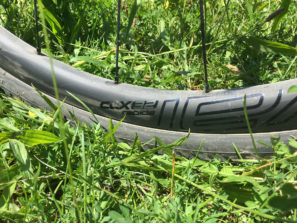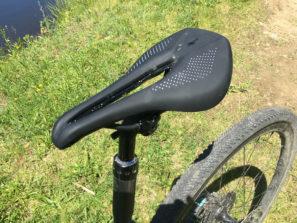Vernon, New Jersey probably isn’t one of the first places to pop into your mind when you think gravel bikes. Serving as the location for the Specialized 2018 road presentation though, the area’s roads and gravel turned out to be a perfect backdrop – especially for the launch of the new Diverge.
One of the main reasons we were on hand at ‘Specialized Summer Camp,’ the Diverge builds on the success of the Roubaix and Ruby road bikes. And even though they share much of the same DNA, the Diverge turns out to be a completely different beast…

During the presentation, Specialized would point out that the gravel or adventure road category is currently seeing their fastest growth. At the current rate, it also won’t be long until gravel is their biggest category overall. That might come as a surprise, unless you’re already exploring new roads, dirt, or gravel on a bike of your own. A “gravel” bike isn’t required to find your own routes and stray from the busiest stretches of pavement, but it can certainly make the experience more enjoyable.
Like other categories before them, not everyone sees gravel bikes in the same light. One of the biggest sources of disagreement seems to come down to not only the use of suspension, but how it’s implemented. As the second distinct model to make use of the Specialized Future Shock, the Diverge copies the Roubaix/Ruby in suspending the rider’s hands rather than the front wheel. The debate between suspending the rider vs. suspending the bike seems to pop up often, so I asked the Product Manager John Cordoba for the Specialized point of view. According to John, the idea to suspend the rider echoes what they were trying to achieve with the Roubaix – at the end of the day, both bikes are road bikes and they wanted them to be as efficient as possible. In testing, suspending the rider added greatly to the comfort at the front end, but had little effect on the bike’s efficiency. When asked to compare it to one of the flex stems of early mountain biking, John said that the position change of the rider’s hands is less with the Future Shock design, only moving up and down up to 20mm rather than moving through an arced path.
While the Future Shock is the same cartridge on Diverge, there is one crucial difference. Instead of the linear spring found on the Roubaix, the Diverge uses a progressive spring that ramps up dramatically towards the end of the travel. To me, this was a big improvement over the Roubaix’s Future Shock since it eliminates the feeling of bottoming out the system almost completely. It wasn’t until riding the Diverge that I really felt that was an issue on the Roubaix, but the feel of the progressive Future Shock turns out to be a big improvement, at least for my liking.

Without the harsh bottom out on big impacts that could happen with the Roubaix, the Future Shock system seems to fade away from your consciousness. It’s still there, and you can watch the system work on the bikes of others, but even on extremely rough terrain it’s easy to forget it’s there (in a good way). The interesting thing about this is that since the Future Shocks use the same design for both bikes, you could easily fit your Roubaix with the progressive spring – and it may be something Specialized is considering for future builds.
After a few solid days of mixed surface riding from smooth pavement to gnarly descents more worthy of a full on mountain bike, there’s no question that the Future Shock helps smooth out the ride at the front of the bike. It doesn’t quite feel like a suspension fork or even something like the Lauf Grit, but there is a noticeable reduction in impacts. Even though the progressive spring is designed to help out on large impacts, the beginning of the stroke is still fairly supple making for a smooth ride on pavement. At one point in the ride, we found ourselves riding the course that Specialized had set up for their XC mountain bikes. It was far more rocky and technical than what most people would consider “gravel bike terrain” but with the right line choice, it showed that the Diverge was surprisingly capable.
In terms of geometry and ride quality, the Diverge isn’t hugely different from a number of quality gravel bikes on the market – which is to say it’s excellent. Without feeling nervous or twitchy, the Diverge rides with a blend of stability and maneuverability which make it feel equally at home in a peloton on the road or threading single track with the dropper down.

Aside from the Future Shock, the dropper post (which is only found on the S-Works model) seems to be the other source of uncertainty for many. After experiencing the short travel dropper for myself, I would certainly run one on a bike of my own – though maybe not in every circumstance. During the riding in New Jersey, the Command Post XCP with its minuscule 35mm of travel still proved to be an advantage during extremely technical descents. Specialized says the idea is to lower you center of gravity even further when riding tricky sections of trail, and it seems to work – as long as you remember to use it.
Even though it proves to be difficult to get used to the idea of a dropper post on a road bike, once you do, you find yourself using it far more than you would think. At 395g, the 350mm length, 35mm drop, 27.2mm diameter seatpost does come with a weight penalty so if you’re riding mostly pavement or flat roads, you may want to leave it off. However, even if you do stick more tame surfaces, if you’re riding any sustained downhills the dropper may still be an advantage thanks to the lower COG and possible gains in terms of aerodynamics. Ultimately though, the dropper will appeal to those who aren’t put off by the idea of this being a drop bar mountain bike with skinny tires.

You tend to hear that comparison a lot when it comes to modern gravel bikes with some sort of suspension, and while there are definitely similarities, the new crop of bikes like the Diverge are far more efficient when it comes to the road. That seems to be the case regardless of wheel size, as I rode the Diverge back to back – once with the 700 x 38c Trigger Pro tires and once with WTB Byway tires in 650b x 47mm. Under hard sprinting, the 700c set up did seem marginally more efficient, but the trade off was a slightly smoother ride and more traction on the 650b tire. I will say that the road plus set up seemed to be a bit more bouncy, though I was running higher pressures than I would have liked (42/40psi) to keep from flatting on the very chunky descents. There were a few pedal strikes on the plus bike, but only when riding the XC trails thanks to a number of tall, pointy rocks. I can’t say the ride of the road plus set up made me crave the set up over the stock 700c wheels and tires, but it’s nice to know it’s an option without adversely affecting the handling of the bike.
There were a handful of lower end Diverges around for test riding, but all of my rides were on the S-Works model which meant I also had the SWAT box to play around with. Fortunately, I didn’t have to use the tube, tire lever, or inflator that are stashed inside, but the multi tool did come in handy for quick adjustments. The box is super handy as a way to have a lot of what you need close at hand, but it is limited. For starters, the box is the same as the one for the Roubaix so it was designed around smaller tubes. Because of that, a 700 x 20-28 standard tube is about the biggest you’ll fit inside, but it will still stretch to fit larger tires. It does have be wrapped very tight in order to clear the sides of the box, so a revised SWAT box for the bigger tires could be an improvement. There’s also no chain tool, and limited tools for the SWAT multi-tool, so you don’t have everything you need for a mechanical, but it seems like a good start. I like the fact that everything inside is there until you need it, without any rattles, or bags hanging off the back of your bike, while again helping to keep your COG as low as possible.
Just as you’d expect from an S-Works level build, the $9,000 bike had an impressive parts spec with choice components like the Easton EC90 SL crankset with a 42t chainring, Roval CLX 32 Disc wheels, and a Shimano R785/XTR/Dura Ace mixed Di2 drivetrain. As nice as the S-Works build is, there are a number of Diverge models at far lower prices, and even a carbon Sport model that comes in at $2,100. Features like the SWAT Box and dropper post aren’t included below S-Works level, though they are compatible with all of the carbon frames.

As usual, two days on a new bike is hardly a definitive answer to how something like the Diverge will perform in the long run. But at this point, the new Diverge did not disappoint. It’s close to road bike efficient while easily tackling some seriously technical terrain. There’s a reason this category is growing so quickly – bikes like the Diverge tend to be more fun, especially when you make that first turn off of the pavement.
For more info on the new Specialized Diverge including geometry and actual weights, check out our first post, here.
















